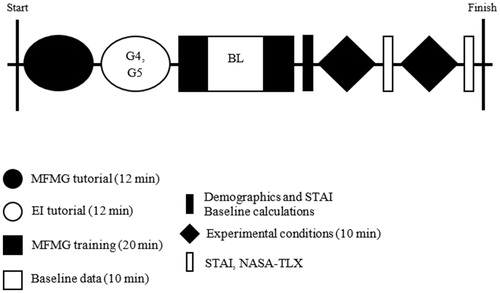Figures & data
Figure 1. Participant view of the experimental set-up. MATB-II was completed using the joystick, mouse, and the computer screen in the foreground, while medical questions were displayed on the large screen directly above and behind. The screen on the participant’s right displayed HR in Groups 2, 3, and 5.

Table 1. Experimental groups (Biofeedback = continuous visual HR; Augmented biofeedback = continuous visual HR and intermittent auditory coping instructions; Prior stress management training = prerecorded video covering emotional concepts of self-awareness and self-regulation and their relationship with stress and coping).
Figure 2. Timeline of basic procedure. Group 1 was the control group and experienced no intervention. Group 2 received a real-time visual biofeedback display during the MFMG training phase and the experimental conditions. Group 3 received the same biofeedback, and intermittent auditory coping instructions during the training and experimental phases. Group 4 received EI training prior to the MFMG training period, but received no intervention during the course of the training or experimental phases. Group 5 received the same EI training prior to the MFMG training period, and also received the same biofeedback display as Groups 2 and 3 during the MFMG training and experimental phases. G4, G5: Group 4, Group 5; BL: baseline; MFMG: Medically-Focused Multitasking Game; EI: emotional intelligence; STAI: State Trait Anxiety Inventory for Adults; NASA-TLX: NASA Task Load Index.

Table 2. Details on participant demographics.
Figure 3. Ultra-short term HRV analysis reveals a significant increase in SDNN values, indicative of a decrease in stress state, immediately following an auditory coping instruction in Group 3 compared to those values immediately preceding the instruction for 10-second (p < .0001), 20-second (p < .05), and 30-second time windows (p < .05). SDNN: standard deviation from normal-to-normal.

